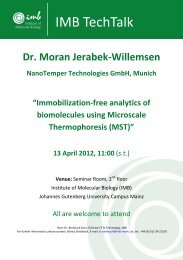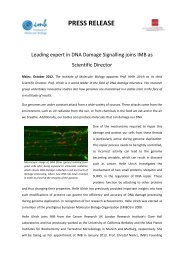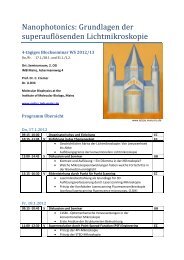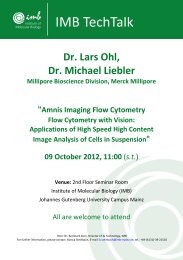Low-resolution PDF - IMB
Low-resolution PDF - IMB
Low-resolution PDF - IMB
You also want an ePaper? Increase the reach of your titles
YUMPU automatically turns print PDFs into web optimized ePapers that Google loves.
26<br />
Bioinformatics<br />
Core Facility<br />
Figure 1. Duplication rate<br />
analysis of RNA-seq data.<br />
Highly expressed genes have<br />
high duplication rates, which<br />
dominate the overall duplication<br />
rate of a dataset. New<br />
quality control tools allow this<br />
effect to be distinguished from<br />
PCR artefacts which might<br />
have been caused by a low<br />
amount of input material.<br />
People: Eugen Eirich, Emil Karaulanov,<br />
Holger Klein, Nastasja Kreim, Joern Toedling<br />
Core Facility Overview<br />
The Bioinformatics Core Facility provides different levels of advanced<br />
data analysis tools and support to <strong>IMB</strong> scientists; this support ranges<br />
from experimental design to data evaluation. The facility is committed<br />
to finding and providing optimal solutions for bioinformatics issues<br />
that arise in the course of research projects. The rapidly changing landscape<br />
of biomedical research and the ever increasing flow of highthroughput<br />
datasets necessitate dedicated and flexible bioinformatic<br />
support for the many projects at <strong>IMB</strong>. The facility enables researchers<br />
to analyse experimental data themselves by providing access to stateof-the-art<br />
software tools with workflows for standard analyses that<br />
can be utilized and adapted to specific problems. Additionally, the<br />
facility offers long-term support and analytical expertise for individual<br />
research projects on a collaborative basis.<br />
In 2012 the facility extended its hardware infrastructure with a file<br />
server of 140TB raw capacity. This is mainly used for next-generationsequencing<br />
datasets.<br />
Selected Publications<br />
Chen CJ, Servant N, Toedling J, Sarazin A, Marchais A, Berthet ED, Cognat V,<br />
Colot V, Voinnet O, Heard E, Ciaudo C, Barillot E (2012). ncPRO-seq: a tool for annotation<br />
and profiling of ncRNAs in sRNA-seq data. Bioinformatics, 28, 3147-3149.<br />
Stumm M, Entezami M, Trunk N, Beck M, Löcherbach J, Wegner RD, Hagen A,<br />
Becker R, Hofmann W (2012). Noninvasive prenatal detection of chromosomal<br />
aneuploidies using different next generation sequencing strategies and algorithms.<br />
Prenatal Diagnosis, 32, 569-577.<br />
Toedling J, Servant N, Ciaudo C, Farinelli L, Voinnet O, Heard E, and Barillot E<br />
(2012). Deep-Sequencing Protocols Influence the Results Obtained in Small-RNA<br />
Sequencing. PLoS ONE, 7, e32724.<br />
In 2012 the Bioinformatics Core Facility analysed datasets in several<br />
in-house collaborations. Data analysed included that from ChIP-seq<br />
(histone modifications and transcription factors, time series), strandspecific<br />
and agnostic RNA-seq (differential expression and isoform<br />
usage, time-series), MBD-seq, Bisulfite-seq, microarray and proteomics<br />
experiments. In the course of the analyses the facility extended its standard<br />
pipelines and engaged in the development of new quality control<br />
tools for the assessment of read duplication rates in RNA-seq. Members<br />
of the facility engaged in consultations regarding experimental<br />
design and data interpretation as well as user training and education<br />
through the provision of the following lectures and practical courses:<br />
• International PhD Programme Lectures: Genomics, ChIP-seq,<br />
RNA-seq, methlylomics<br />
• International PhD Programme Practical Courses: Galaxy, Chipster,<br />
Genomatix<br />
• International Summer School: Bioinformatics for next-generationsequencing,<br />
data analysis<br />
• Other Seminars: Four lectures on various sequencing technologies<br />
Services Offered<br />
The Bioinformatics Core Facility provides assistance on two levels:<br />
1. General support to the <strong>IMB</strong> user base:<br />
• Assistance with experimental design of high-throughput assays<br />
such as ChIP-seq, RNA-seq or Bisulfite-seq<br />
• In-house training and tutorials on bioinformatic tools and databases<br />
to facilitate data access and analysis<br />
• Implementation and adaptation of open-source tools and commercial<br />
software solutions for “omics” data interpretation<br />
• Setup and development of analysis pipelines for sequencing,<br />
microarray, cytometry and microscopy data<br />
• Quality assessment and pre-processing of raw data coming from<br />
the sequencing instruments<br />
2. In-depth assistance for individual projects:<br />
• Comprehensive high-throughput data analyses, interpretation<br />
and presentation of results<br />
• Development of custom tools to address specific bioinformatic needs<br />
• Exploration and implementation of novel analysis methods and<br />
pipelines<br />
• Data mining of “omics” databases and published high-throughput<br />
datasets<br />
The following bioinformatic resources were installed or updated to<br />
newer versions at <strong>IMB</strong> in 2012:<br />
• R-Studio: new installation. A server frontend for the statistical<br />
programming language R and BioConductor packages<br />
• GALAXY-LIMS: new installation. A customized version of the<br />
Galaxy laboratory information management system<br />
• GALAXY: customization, upgrade and tighter infrastructure integration.<br />
An open-source environment for genomics data analysis<br />
• GENOMATIX: upgrade and tighter infrastructure integration.<br />
Commercial software for performing standard next-generationsequencing<br />
data mapping and analysis tasks<br />
• CHIPSTER: upgrade. Open-source data analysis platform for<br />
various types of microarray










